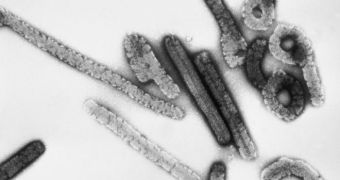40 years after it was first reported in Europe, the Marburg virus returns and it seems that it has claimed its first victim on July 11, when a woman returning from a trip in Uganda died in a hospital in Leiden, Netherlands. According to NewScientist magazine, the 40 year old woman had visited a series of caves approximately three weeks prior to her death, albeit she developed a fever only after returning back to Netherlands early in July. Liver failure and multiple hemorrhages followed only two days after she was admitted to the hospital.
The Marburg virus, named after the German city of Marburg where the disease was first spotted nearly four decades ago in monkeys in a research facility, is an agent triggering the Marburg hemorrhagic fever, both the condition and the virus itself presenting close similarities to the Ebola virus of the Ebola genus of the Filoviridae family.
After it was first reported in 1967, the Marburg virus infected a total of 31 people in Marburg, Frankfurt and Belgrade, seven of which died before the virus completely disappeared from Europe. The virus appears to originate in Uganda and the Democratic Republic of Congo in Egyptian fruit bats, although its source has not been confirmed yet.
Peter Walsh of the Max Planck Institute for Evolutionary Anthropology says that the virus doesn't seem to affect its carrier and it can be spread by the bats that live in caves. Also, cave-to-cave transmission led to genetic variations of the virus, which can also account for the fact that out of the total number of infected people when the virus first appeared in Germany, only 25 percent died, as opposed to the outbreaks in Congo and Angola, this past decade, which resulted in the deaths of up to 90 percent of those infected.
So far there is no cure for this horrible disease, although we have seen a significant progress in the study of the Marburg virus in Macaque monkeys, which develop immune systems able to fight the condition when injected with an unrelated virus that produces a key Marburg protein. However, similar techniques do not seem to have any effect on humans.
Additionally, the disease is contagious only when a person comes in close contact with an individual showing symptoms of the Marburg virus. So far, none of the persons that came in contact with the Dutch woman appear to have contracted the virus.

 14 DAY TRIAL //
14 DAY TRIAL //